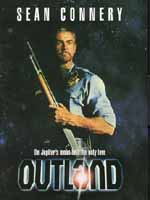
Arch
443/646: Architecture and Film
Fall 2005
Outland
(1981)

 |
Arch
443/646: Architecture and Film Outland |
 |
Discussion
Questions:
Please answer the questions below. Use paragraph form. Your answer should be around 400 words. Email me your responses in Word .doc format to: tboake@sympatico.ca I will be posting these each week after the class. You should be prepared to deliver your answer in class -- but paraphrase, do not read it. Screencapping
this film was tough, because it is so dark. Peter Hyams, the director,
wanted it that way. This is an excerpt from an interview: Luke: "Why do you like to use natural light so much?" Peter: "I don't. I never have. I don't like it. The camera is not a recording device. The camera's a negative. I think photography should be heightened. I love shadow. I love the dark. I love changing the color of light. People write about cinematography and they don't know what they're talking about. Nobody knows what natural light is. When you build a set, how can it be natural light?" Luke: "I guess there's that perception because you work so much with shadow." Peter: "You make shadow. I love the dark. I love the source of light. I love the bent of light. I remember going to museums as a kid and studying painting. Look at Rembrandt. I think I've spent my life looking for the perfect terminator, for that miraculous moment when light seems to expire of old age around somebody's cheek. "I think there's no excuse for photography not being adventurous. I think the biggest sin that anyone can commit is conservatism in any art form. I don't think there's an excuse for a photograph to be mundane." Luke: "You try to approximate natural light?" Peter: "No. I try to make something that I think is dramatic. Somebody sitting beside a window [as I am], I like to see the window. I like to see the light coming through that window. I like to see the key side of their face X amount of stops over and the shadow side of their face X amount of stops under. And whatever that X factor is is part of the skill of exposure." Peter Hyams went to art school and also worked as a Viet Nam war correspondent. Hyams wanted the film to be about the grit of a "mining town" in space. Keep this in mind when viewing the film sets as well as plot development. Does it hold? |
updated
20-dec-05 9:11 AM
1. B J Smith The greenhouse space in Outlander does not appear until the end fight sequence takes place, leaving the audience unaware of its existence and ignorant of its use. As a result we are not entirely clear as to its purpose, nor are we completely sure of how it works. If indeed its main purpose is to create oxygen through the photosynthesis of plants, the next series of speculation surrounds the operation of the space. How does it work and what does it use for light to nourish the plants? During the fight scene, one will notice that the space does have translucent surfaces between the greenhouse and exterior atmosphere. Therefore, does this suggest that the greenhouse uses the natural light from the sun or even Jupiter? Although nothing else in the film would suggest that any sufficient amount of light reaches the mining station on Io. Similarly the film has a darkness to its sets, and rarely is there seen any porthole or window in the spaces of the mining station. Therefore one could postulate that there is insufficient natural light on Io for the greenhouse to flourish and must rely on the use of artificial lighting for the plants. Therefore the set design is making use of the audience’s preconceived idea of what a greenhouse needs to be. Creating credibility for greenhouse construction/ architecture yet negates the credibility of its ability to function. On the other hand it is quite plausible for a station on another planet with an unsuitable atmosphere to require such a space. The best way to supply an entire station with a renewable source of oxygen would be to have a large greenhouse which converts carbon dioxide into oxygen just as it would on earth. Therefore the need for this space is quite credible, even if its realization in the film is somewhat flawed. Likewise the actuality of the space also seems quite plausible, as the size of the space and their constructions seem reasonable and quite believable – in fact much more believable than the greenhouses seen in Silent Running. |
||
2. David Takacs
The film Outland is characteristic of numerous other Hollywood films in the science fiction genre through countless ways, including character development, acting, sets, and overall style. Though perhaps no feature is so pervasive to this genre as that of hexagonal geometry defining ‘space architecture.’ Important to analyzing this point is not only does it work, but why and how this is the case? It was in a ‘making of’ feature of a science fiction film where the director spoke of the sets being made of the most engineered, geometric shapes, which are absolutely efficient in all regards. This can be seen to be the primary dogma of ‘space architecture.’ The idea that the future holds the pursuit for pure survival, whereby ancient Athens will be seen to be more alien than anything else. This is a future where there are no designers, and instead everything is determined by numbers. There are other things to consider, such as the idea that a shape with more sides is stronger than a rectilinear shape. Triangulated shapes often also take up less space, and are easier to construct. The last thing to note is perhaps the overall reason for the predominance of geometric shapes in science fiction films, and this is the desire to be different. In predicting the future, an appetizing theory is to be different. Whether it works or not, it is conceivable only in its newness. The ultimate proof of this working is the dominance of these shapes in science fiction films, clearly no one has complained yet. From a structural point of view we can ask one other question; are these materials believable in such harsh environments? Short of doing a yield test on a fictitious material we cannot prove this, but there are a few facts which certainly seem to make it believable. The very nature of the film lends credit to such technical developments. If there are men mining at zero atmospheres, surely the construction methods have been perfected. Also the ease with which the men work from the triangulated trusses, or the way a character runs through a seemingly quite complex hexagonal bridge system certainly adds to the believability of such materials, perhaps best called ‘usability.’ Though these forms may be devoid of any thought other than one of maximization, they indefinitely work for the science fiction genre, but perhaps only until they invade reality. |
x | |
3. Andrea Wong The film’s set is primarily dank and dark. It is constructed of hard surfaces of dark grey tones that seem very unforgiving. The viewer gets a claustrophobic impression that this is not a very nice place to be and that it is an optimal environment for conspiracies and secrets. In fact, the most obvious characteristic of the medical quarters in this movie is that they are completely the opposite of the rest of the set. They are bright, white, and glossy. The atmosphere seems airy. Large sliding glass doors divide the compartments which enable transparency throughout the medical facility. Their openings and closings happen in a smooth and swift manner, having no impact on the occupants of the space. This clean and pristine look definitely generates a positive view of this area and the activities that go on here. It harbours a feeling of trust and of truth. This is where O’Niel comes for the answers to his questions and he receives them. |
||
4. Derek
McCallum The gravity situation on Io is, for the first time in a few films, actually given appropriate attention. The occupants of the mining settlement are terrified of the exterior environment, because they know what it will do to them. The gruesome footage shown of people’s heads exploding and bloodstained space-helmets provide strong images that the film’s viewers begin to associate with gravity. The forced zero gravity as punishment reinforces the idea that gravity can be a dangerous and painful thing. To be suspended in space and have absolutely no control over your movements would be enough to drive someone mad after enough exposure. The zero gravity room reinforces the danger of the exterior environment on Io. These things all work quite strongly towards supporting the proposed space environment for the film. There is a very clear relationship between inside and outside – in this case, alive and dead. This is illustrated most strongly through the scene when Connery is speaking to the zero gravity prisoner by phone through a glass wall. That delicate (although presumably it would be very thick) threshold is all that separates control from chaos, life from death. The space environment portrayed on Io is quite believable because it pays special attention to the dangers of exterior space, and contrasts them very effectively with the “safe” gravity of the interior environment. |
||
5. Helen
Pallot O’Neil’s apartment is quite a contrast to the other interior habitats in the movie. It shows attention to detail, a private and intimate setting and follows an individual form and arrangement of space. Unlike a lot of the different spaces there is no set shape or order, it has an independent structure, that could be created by panels of some sort. These are placed and arranged according to the different functions within the apartment. The main spaced being the kitchen and living area, which are separated by the walkway into another open space that makes the electronic den and hall for the bedrooms and washrooms etc. The kitchen is designed in a modernist modular form, using the spaces as efficiently as possible. The technology used is believable, it is not that specific but there is a microwave of some sort, and an oven, etc. That further into the future there probably would be more sophisticated technology however, it does not seem to be of particular significance or add extra value to the movie. The Electronic den on the other hand is quite dated in our present day, the video recordings and communications do illustrate a forward thinking and are still used today, it is more the aesthetic composition of the equipment that is a bit crude. The entry of the apartment has a foyer area which is labelled “fire control” this demonstrates that the concepts of an air lock system is a consistent safety element throughout the station. That they have treated all parts of the interiors as a whole entity, which makes the interior spaces more believable. The surfaces in the apartment have been textilised by netting materials, creating a transparent effect. The kitchen and lounge both predominantly white/creme, they contrast the public and working class spaces which greyish and dark colours are more predominantly used. There are interesting contrasts towards the labourers working and living quarters compared to the administration, medical and security work and living quarters, it creates different social classes and the hierarchy on the station. So the materials taking on the similar textures but being treated in different ways once again ties in that the station is treated as a whole but these divisions are made by the detail. The working class spaces look like heavy duty materials, ones that are harder to damage, and creating less intimate spaces. Were as the screens and materials in the apartment have a refined touch, they are much more inviting and create intimate settings of privacy and luxury. This can also be said for even the lighting, in the apartment the placement of lights compliment the surroundings highlighting the edges of the couch, or the different panels in the kitchen, were as a flood light effect is used in the dinning and living quarters for the miners. |
||
6. Allison
Janes The spacesuits depicted in Outland are designed for a zero pressure and airless environment. The suits become a hybrid of the miner’s coverall and the conventional space suit, particularly the space helmet. The spacesuit should be robust for the actions taking place on Io. The design of the spacesuit would have to take into account the mobility of the miner while considering the level of rigidity or strength needed to prevent perforations of the spacesuit material from the rigors of such physical labour. The jumpsuit or coverall design of the spacesuits suggests that the mobility of the miner has been taken into consideration although in the typical form of industrial wear. One could speculate that super fabrics or other materials have been invented at this point to withstand the wear and tear while still being flexible. The need for a continuous airtight seal is displayed in the architecture of the film with the many failsafe airlocks and elevators, however the realities of an airtight seal in a spacesuit does not seem to be addressed. The gloves in particular appear to be attached with a Velcro like material. They are quite separate from the suit and take the form of typical gloves. This is also in contrast with the apparent need to pressurize the suits before moving onto the airlock elevators. Each miner must attach his suit to one of a series of nozzles both before and after a spacewalk. The fragility of life in space is again evoked through a flimsy tube that connects the air tank to the miner’s helmet. This seems to be a consistent device in the films we have seen, particularly in 2001, which like this movie emphasizes greatest moment of action with the death of a character by the cutting of the tube. The use
of lights inside the helmets is an interesting film device because
they illuminate the character’s face, thereby
identifying him in the otherwise dark environment. Their proposed function
in the film is to illuminate the field of work in front of the miner.
However by placing lights inside the glass of the helmet, it becomes
impossible to see out. The miner would be blinded by reflected light
from the curved face of the glass and the dark environment outside
would cause the glass to act as a mirror, creating the same condition
of looking out of a window from a light room at night. |
||
7. Mat
Triebner The architecture of the sleeping quarters, characterized by a squadron of suspended metal cages and movable metal staircases serve the necessary utilitarian purposes for a mining operations centre on Jupiter’s Io and look wonderfully cool doing it. While perhaps not intending to look like an anti-flagship, the sleeping area bears a remarkable resemblance to Rem’s Soho Prada, specifically the upstairs portion of the store, with its movable display racks of metal mesh and post-industrial finish schedule. While the outfits may differ slightly in appearance and price, the method of division of space remains essentially the same, although the density of said cages seems entirely greater in the set of Outland. Aside from the inherent coolness factor of the sleeping quarters, they provide an incredible set for the film, particularly Sean Connery’s dramatic chase seen which utilizes the space as a Escherian maze. The multi-tiered system of the sleeping quarters seems to operate with a shifting ground plane, and we are never certain (especially in the case of the chase scene), where the lowest level truly lies, adding a sense of disorientation to the scene. The hanging volumes have a great ability to form a physical barrier but at the same time remain transparent, creating a system of layered volumes. Which again, is quite engaging. This ability to create a multilayered, adjusting space is largely reliant on the materiality of the sleeping quarters, which is based on an industrial aesthetic, using chainlink and other metal products to create a rawness that just so happens to look incredibly slick. The interior spaces of the cages seem rather unpleasant however, and though they have not abandoned the aesthetic of the spaces outside the cages, they seem far less interesting. The solution of blinds to conceal ambient light betrays the coolness of the remainder of the space. Slick shutters, metal or otherwise would have been more in keeping with that aesthetic rather than the flimsy blinds favoured instead. The integration of the light in the chamber itself is far more eloquent and in keeping with the design with the rest of the quarter. Moving past the allure of the industrial aesthetic of the space, we have to consider just how painfully unpleasant the space would be in actuality, and that in reality, no one in their right mind would ever want to spend time there.
|
||
8. Matt
Storus What do you feel is the purpose of the predominant use of "translucent/grated" materials in the film? The grated and translucent material serves to enhance the mood of the movie in two ways, as well as provide a visual trope necessary to the dramatic conclusion of the film. At a basic level, the translucent and grated material provides a partial transmission of light through its mass. Primarily, this notion of partial vision removes any traces of privacy that the miners might hope to have. The scenes that pan through the living quarters of the miners shows that partial visual access is granted to their private quarters, across multiple levels. The negation of privacy due to the translucent materials furthers the theme of surveillance that runs throughout the film. Conversely, the translucent material also blocks a certain percentage of light from passing through its mass. This can readily be seen in the dark and ambient nature of the light within the mining colony which gives the impression that the place is gritty and dirty. And although ones sense of privacy is removed, the surveyor can never quite get a full view of what is happening. This is particularly evident in the early chase scenes between Sean Connery and the drug dealer, where the drug dealer is constantly obscured behind multiple levels of visual barriers. Overall, the translucent and grated material serves to increase the ubiquitous sense of paranoia that is presented as an important theme in the movie. Finally, the chase scene in which the bounty hunters come to kill Sean Connery is essentially a series of shots that play upon the theme of translucency. Whether the camera is looking up through a grate, or through the eyes of the hunter as he peers down his sniper scope, or through the translucent cladding surrounding the greenhouse, a clear image is never granted. This serves to enhance the drama and suspense of the pivotal chase scene. Elfie Kalfakis: The uses of materials within the movie Outland portray the desired dark environment of Peter Hyams. Typically transparent materials seem to create cohesion of spaces in most architecture. However, within the film, Hyams’ use of transparent has an inverse effect. Being in outer space transparency doesn’t alleviate the confinement of the indoors that humans desire on Earth. On the contrary, in a zero-gravity environment, the exterior conditions are not desired, and enclosure from the dangerous outdoors would create comfort. With the use of transparent materials Hyams alludes to three issues: 1) to address and illustrate the harsh environment of the film’s setting, 2) to create a tension in the film displaying seemingly reliable but actually dangerous conditions in which the workers live and 3) to illustrate a lack of privacy. The transparent materials appear to have created an invasive environment. The sense of retreat and isolation is lost. This also alludes to the idea of control, where everything is seemingly under surveillance. The use of grated materials also alludes to ideas of control with respect to confinement; a prison-like atmosphere is created. Deceptively, at the films beginning, the grating is in relation to the external environment of the mining village, locking out the harsh conditions of zero-gravity. By the film’s conclusion we are enlightened and realize that it’s not exactly a high-tech enclosure but more of a high-tech hell; a place where workers are controlled, confined and eventually murdered. Additionally, the high-tech & transparent materials of the sets create an overall dehumanizing character for the film. Humans being mere pieces of the machine, (only accounted for quantitatively not qualitatively), is supported by the compartmentalizing of the living quarters. The living quarters mimic the same patterning on the exterior grating of the space village. By rendering the worker’s living space with machine-like materials, (mimicking the overall façade of the station), insinuates their insignificance. Alongside this the lack of privacy created through the use of transparent materials and the insinuation of a prison environment with the use of grating asserts the inferiority the workers have. On another note, the materials allowed Hyams to further control the lighting effects in the film. Using materials such as grates, Hyams could filter the amount of light penetration and precisely create the desired atmosphere. Also with the use of grates and transparent materials, much could be explored with shadow. Overlapping transparent and grated materials creates an another dimension to the film set, "No. I try to make something that I think is dramatic. Somebody sitting beside a window [as I am], I like to see the window. I like to see the light coming through that window. I like to see the key side of their face X amount of stops over and the shadow side of their face X amount of stops under. And whatever that X factor is is part of the skill of exposure." – Peter Hyams
|
||
9. Elfie
Kalfakis The
food and "method of eating" in this film is quite different
from that proposed in 2001 or Silent Running. Is the food proposed
for this film believable? Does it support the plot? (second image, just
keep your eyes on the fries...) |
||
10. Nathan
Rehorick Principally, structures in Outland are steel, modular units composed of thin triangular or rectangular steel space frames, or heavier steel beams and columns. These serve as both structure and interior and exterior finishes. Speculation on the reason for use of space-frames might be two-fold. Firstly, as a lightweight structure that can be easily transported to Io and then quickly assembled, these steel frames make sense. Alternately, they seem to serve a cinematographic purpose as a matrix through which miners can interact. This is illustrated when O’Niel chases the drug runner through the residential area. In other instances, scenes looking down long corridors or at the exterior of the mining tower give a moody, scary atmosphere to the environments. The accumulated dirt on the steel and the lack of colour adds to this atmosphere, reflecting the grittiness of mining colony life. As well, these frame structures, while providing a barrier of movement in certain cases, are nonetheless hollow and transparent. This notion of transparent boundary is reflected in the way that the security staff and much of the rest of the colony’s personnel are conscious of the illegal smuggling activities of Sheppard and his crew, yet turn a blind eye. In some areas, large retaining walls are present, perhaps to hold back the mining excavations, and sit in juxtaposition with the steel frames. There is a strong feeling enclosure in some of the interior spaces where this condition is present, especially with no visible connection to the exterior (this may mean that these spaces are embedded within Io’s bedrock). Coupled with the matrix of steel running throughout, these spaces have a strongly claustrophobic feel. Overall, the materiality of the mining station seems to be driven by cost and other functional issues such as unitization of personal space, ease of construction. Modular steel systems respond to these issues and seem to be a realistic proposition for the materiality of the construction of the buildings in Outland. Reference: Fanti, Dennis. Outland Web Review. Fall, 2002. http://www.architecture.uwaterloo.ca:16080/faculty_projects/terri/pdf/outland_fanti.pdf
|
||
11. Emily
Maemura Three main scenes of leisure are presented in OUTLAND: the bar, the squash court, and golf. All of these scenes are suited to life in space, especially a mining colony in space. Both the scenes of sport, golf and squash, are presented in cramped spaces, adapting to the closed environment of life in space. In contrast to Silent Running, and 2001, these scenes seem to portray a sense of the economics of life in space. The type of recreation in Silent Running, with its vast sets which can facilitate car chases, seems unlikely for a ship with a crew of four people. Similarly in 2001, the amount of space in space seems taken for granted. In Outland, space is treated quite modestly,a greater number of people are livingtogether, and all space, especially that of leisure is restricted. One rather alarming quality of the office golf scene is its prescience, and closeness to reality. One can imagine these virtual reality driving ranges, and executives practicing putting in their offices. The squash scene seemed rather realistic as well, working with an existing, well known game that uses a limited sized court. The main form of recreation which seems unsuited to the size of the mining colony was the size and scale of the bar presented in the film. Perhaps this is one of many bars, but it seemed disproportionate to the number of workers presented at the beginning of the film.
|
||
12. Liana
Bresler |
||
13. Maia The architectural set which describes the “personal space” and “the privacy” is reduced to metallic cages, iron scales and dark background. This provoks a loss of identity for any inhabitant of the navy space. Every individual carateristics is destroyed. People look like robots, automatons, without vitality or personality. These metallic cages look like subtle sails of separation, fragile diaphagrms between what they are and what they are living. The white color of the cages and people dressing give us the idea of dissolvment and rarefaction. White is the color that is nearest to trasparency, so this again gives us more of the idea of “non-existant”. This seems to mean that what happens in this context is not really important. Spaces remind us of interlocked spaces whitout exit, like in Escher’s paintings or the labyrinths in Piranesi’s drawings.These are spaces in which the individual identity is confused with the complicated and articulated environment. There are steps that go up and down and we can’t understand where they get to and finish, also because the camera focuses on details, not on extended views. Actions take place on different layers, or different “floors”- the levels of the cages- but everything is explained and described whit only few elements. Few materials, few lights, few views. Washbasins, washrooms, stacked beds on top of one another .... the feeling is the same from a prison or a military barrack, which host only teams of detainees, not single individuals. Perhaps there isn’t enough time for anything personal or for “privacy”. The rhythm of the film is too articulated, fast and rich of plots and actions, intrigues, conspiracies, events. There is no time for thoughts, reflections, leisure and the rest. All these activities require intimacy and privacy, but this is not really the best place to develop personal intellectual assets. Everything is grouped, everything is “mass, multitude, piles”. Everything is standardized. It is a serial riproduction of wretched ambients of suburbs and outskirts of an ugly city. Scenes are dark, lifeless and colorless. I am not sure that all this “impersonality” is necessary. I think it is done to keep the attention on the action of the film and stay concentrate. I don’t think there is a real intention to express or to convey some special feeling. It is just a way to describe the background which is not really important to the meaning or the outcome of the film. |
||
| x | 14. Davide Introvision is a cinematographic technique developed by Intravision Corporation in 1981 It’s derived by the front-projection system. Front projection was used for the first time in 1932, conceptually is not very different from the classic trick to pt the actors in front of a painted background. With the improvement of the photography and the film-editing, the painted screen was no more used in favour of the Front-projection system. Images are projected from the back of a screen and the actor acts in front of them. In this way we cannot tell where the set ends and the projection starts. Use of front projection is very common, there are many famous frames in which the actors are in an automobile, they are driving and the landscape around them is moving but we can’t realize that the car is often inside a dark studio. Front projection is used in Kubrick’s 2001 and Star Wars. The Introvision allows actors to appear not only in front of the screen but also with different angles and behind the screen. In this way the elements can be enlarged, reduced and filmed with different perspectives. In Outland Introvision was very effective and allows to design a space starship in a model only 6 meters height. Sean connery can wander through the model of the space station with a full optical interation at 360 degree. We cannot realize that the model is a miniature model and has been manipolated with intravision special effects. The movement of the actors and the photography are realistic not only in indoor space but expecially when the characters fight outside the space station. Intravision allows not only producers to save money but also to create surreal interations. Maybe the most famous apllicaiton of intravision in in 1983 in “Inside the Third Reich” where we can see the actors of Adolf Hitler and of Albert Speer walking inside the Reichstag (now destroyed). Introvision is used also in other popular films like Rambo III, and The Fugitive. Nowadays with the improvement of the computer graphic, Intravision could seem out of date, but this years the company annouced the opening of a new and sofisticated studio in LA valley that could figure out a new revival of this technique. |
|
| v | v | |
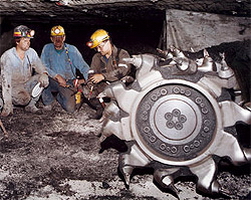 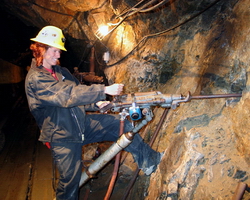 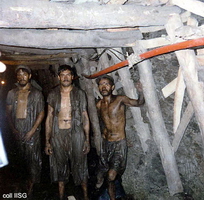 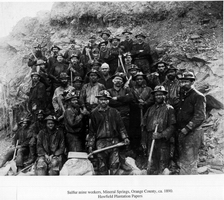 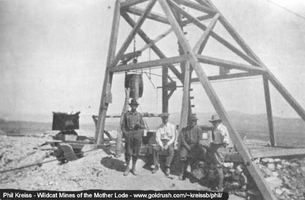 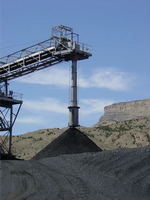 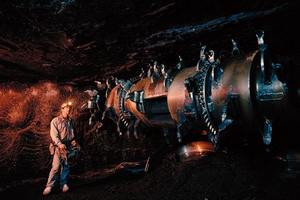 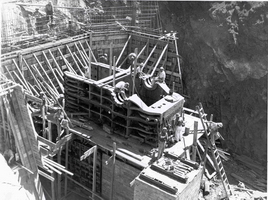 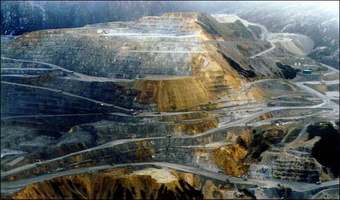 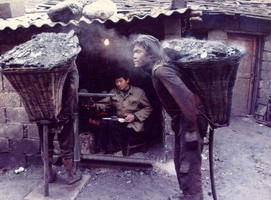 |
||
And below are just some musings of my own ... I really don't know: |
||
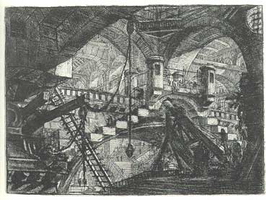 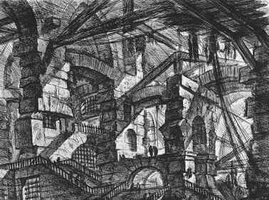 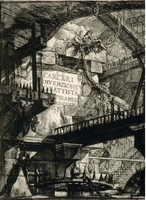 |
||
| x |
|